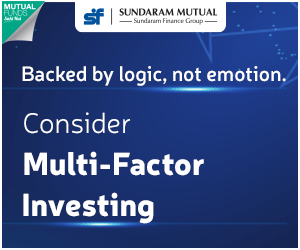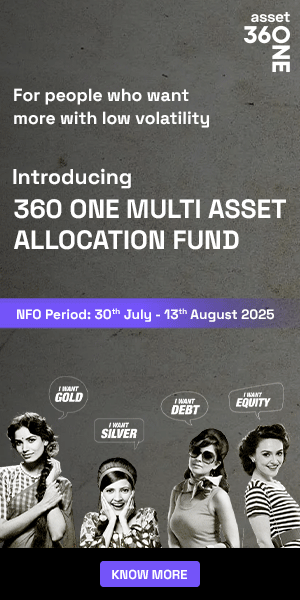Edelweiss Balanced Advantage: Unique dynamic asset allocation with superior return potential

With the onset of volatility in the stock market earlier this year, dynamic asset allocation hybrid funds are in flavor with investors. As part of SEBI’s mutual fund re-classification initiative, dynamic asset allocation funds or balanced advantage funds has been made a separate sub-category within hybrid funds category. Unlike fixed or static asset allocation hybrid funds, commonly known as balanced funds, dynamic asset allocation funds change their asset allocation with varying market conditions.
Dynamic asset allocation strategy yields lesser volatility of returns compared to fixed asset allocation strategy and thereby, reduces downside risks in market corrections or bear markets. Dynamic asset allocation provides stability to your investment portfolio and offers a better investment experience. The chart below shows the probability of negative returns over various investment tenors for pure equity, fixed asset allocation (50:50 equity to debt) and dynamic asset allocation (30 – 80% equity) strategies. You can see that the downside risk of dynamic asset allocation strategy is significantly lower.
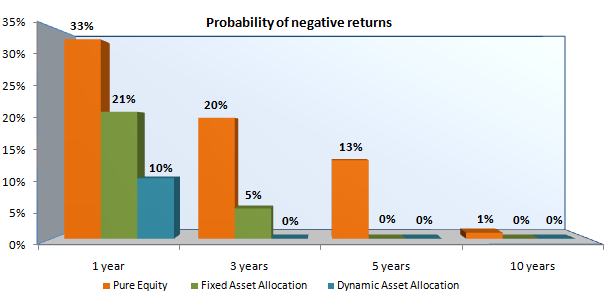
Source: Edelweiss Mutual Fund
One of the key characteristics of dynamic asset allocation strategy is that it should be primarily model driven and not left to the discretion of the fund manager. In the last few months we have reviewed a number of dynamic asset allocation or balanced advantage funds in our blog. In this post, we will review Edelweiss Balanced Advantage Fund, a dynamic asset allocation fund, which has a unique asset allocation strategy differing from most dynamic asset allocation or balanced advantage funds, which we have covered earlier in our blog.
Edelweiss Balanced Advantage Fund
The fund was launched in August 2009 and has around Rs 850 Crores of assets under management (AUM). The expense ratio of the fund is 2.45%. The fund has given double digit CAGR returns since launch. The chart below shows the NAV movement of the fund since inception.
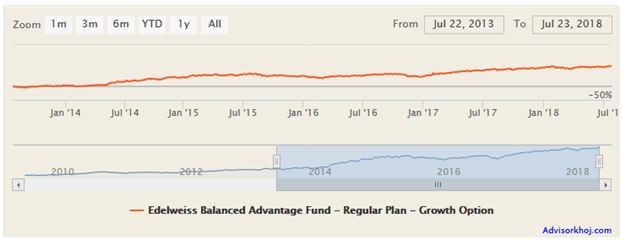
Source: Advisorkhoj Research
Rs 10,000 invested in the fund 5 years back would have grown to Rs 18,305; a compounded annual growth rate of 12.85% (please see the chart below).
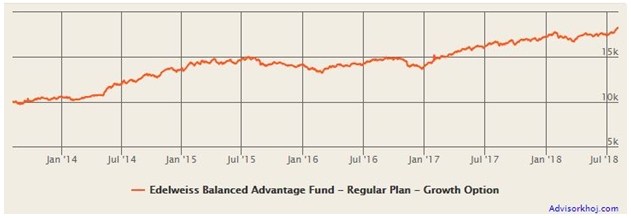
Source: Advisorkhoj Research
Bharat Lahoti, Bhavesh Jain and Gautam Kaul are the fund managers of this scheme. Let us now discuss how Edelweiss Balanced Advantage Fund is positioned uniquely vis-a-vis most dynamic asset allocation funds.
Unique positioning of Edelweiss Balanced Advantage Funds
We have discussed a number of times in our blog that risk and return are directly related. The asset allocation of an investment portfolio has a direct bearing on the risk profile of the portfolio. Accordingly different types of the mutual fund schemes have different risk / return profiles. The chart below shows the positioning of different types of funds in the risk return map.

You can see that the positioning of Edelweiss Balanced Advantage Fund overlaps dynamic asset allocation funds and also partly aggressive hybrid funds, the erstwhile balanced funds. The risk profile of Edelweiss Balanced Advantage Fund is similar to that of Dynamic Asset Allocation funds or Balanced Advantage funds, but the return potential of the fund can match aggressive hybrid funds. This unique proposition is a potential win-win situation for investors – limited downside risks and higher upside potential. We often suspect that some things in the world are too good to be true! We need to explain here, how Edelweiss Balanced Advantage Fund differs from the typical dynamic asset allocation funds that we have covered over the past few months.
Difference in investment strategies: Counter-cyclical versus Pro-cyclical
Let us first discuss how asset allocation models of most dynamic asset allocation funds that we have covered earlier works. Dynamic asset allocation funds usually employ a valuation based asset allocation model. If equity valuations, measured in terms of Price to Earnings (P/E) or Price to Book (P/B) ratios are high (stocks are expensive) then the asset allocation model will reduce exposure to equity and increase exposure to debt. If equity valuations are low (stocks are cheap) then the model will increase equity exposure and reduce debt exposure. The fund managers of these dynamic asset allocation funds tell us that they are essentially buying low and selling high– the best way to make money.
It seems like a logical approach from a theoretical standpoint, but investors who trade in stocks or follow the stock markets know that the market in reality does strictly adhere to the value framework. If the market is rallying, the upward momentum is likely to carry the market further upwards. If you follow a valuation based asset allocation strategy then you will reduce equity allocation on every rally in bull market. By reducing equity exposure in rallying market (bull market), you are leaving money on the table – depriving yourself of profit opportunities. Similarly, when the market crashes, the downward momentum can send the market even lower – we see this in almost bear markets. If you are increasing your equity exposure in bear markets, your short term losses will be higher.
Why does the market trend higher in bull markets, even though valuations are dearer and vice versa in bear markets? Stock price movement is not just driven by fair value (intrinsic value) but other factors as well like liquidity (domestic and FII), risk sentiments (domestic and global) etc. The reality is that investors put more money in stocks in bull markets, irrespective of valuations and pull money out of stocks in bear markets. Therefore, valuation based asset allocation strategy is contrarian, against the trend. Hence this strategy is counter-cyclical.
In the stock market, there is a saying that the trend is your friend. There is a school of thought in the market which says that you can make more money following the trend than going against it. Edelweiss Balanced Advantage Fund follows the trend in different market cycles. The main principle of the model of the fund is increasing exposure on winning side (equity in bull market) and reducing exposure on losing side (equity in bear market), thus harnessing the power of compounding in an effective way. This asset allocation strategy is pro-cyclical.
Trends can last quite long in equity markets and trajectory of the trend often defies valuations, especially in our market. Further, the inflexion point of trend versus valuation is often very difficult to guess. Take the case of midcap and small cap stocks – these stocks were trading at high valuations for a long time, but valuations just kept going up, even up to 50 – 60 times earnings. If you followed a valuation based asset allocation strategy then as discussed earlier, you would have left a lot of money on the table.
Edelweiss Mutual Fund believes that, a pro-cyclical dynamic asset allocation strategy is superior to a counter-cyclical one in a market like India, because it avoids timing of market reversal (inflexion point of market trend versus valuations), captures bigger trends and limits drawdown, and in the final analysis, gives superior risk adjusted returns. Both counter-cyclical and pro-cyclical have their merits and demerits. As an unbiased content and research portal, we in Advisorkhoj, will rely only on hard data to see the efficacy of any investment hypothesis. The method to test the effectiveness of an investment hypothesis is known as back-testing - let us test, how counter-cyclical versus pro-cyclical dynamic asset allocation strategies compared versus one another in the past (different historical market conditions).
Back-testing Pro-cyclical versus Counter-cyclical strategies
The chart below shows the returns of pro-cyclical and counter-cyclical asset allocation strategies versus the Nifty for the last 13 years covering different market cycles (both bull market and bear market). Both dynamic asset allocation strategies beat the Nifty in bear markets – which is to be expected. But which asset allocation strategy was better? Pro-cyclical dynamic asset allocation strategy outperformed dynamic asset allocation strategy in most years. Notice how pro-cyclical dynamic asset allocation outperformed counter-cyclical asset allocation in the bear market years (circled in red).
Now notice, how the two asset allocation strategies performed in bull market years (circled in green). In most bull market years, pro-cyclical dynamic asset allocation outperformed significantly providing equity like returns. This back-testing proves the efficacy of pro-cyclical dynamic asset allocation hypothesis.
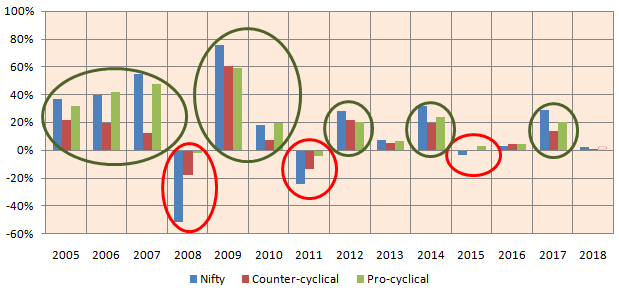
Source: Edelweiss Mutual Fund
Edelweiss Balanced Advantage Fund asset allocation model
As discussed earlier, Edelweiss Balanced Advantage Fund uses a pro-cyclical asset allocation model. The underlying framework of the fund’s dynamic pro-cyclical asset allocation model is Edelweiss Equity Health Index (EEHI). Edelweiss Equity Health Index (EEHI) is a proprietary model that incorporates market directions, volatility and fundamentals. EEHI considers the following factors:-
Market trend
: Nifty’s 1 week, 2 week, 1 month & 3 months Daily Moving Average (DMA). We had discussed about DMAs earlier in our technical posts, but for the benefit of all our readers, DMA is the average of stock or index prices / values on a daily rolling basis for the trailing period (1 week, 2 week, 1 month, 3 months etc). DMAs indicate bull or bear market trend – if current market price (CMP) is above the DMA it is a bullish trend and if it is below the DMA it is bearish trend.Trend health
: Short and long term volatility, including Nifty’s downward deviation (volatility in down markets). This indicates the strength and sustainability of current bull/bear market trend. Volatility usually indicates investor sentiments– low volatility indicates complacency and high volatility indicates fear. There is a reasonably high correlation between volatility changes and market trend reversals.Fundamentals
: Market trend and trend health are the core factors in EEHI model. Fundamentals are an auxiliary factor. Fundamentals are based on market Valuations and macro-economic factors. It indicates the overall economy trend and its strength
How did EEHI asset allocation model work in different market conditions?
The chart below shows average equity exposures in different market cycles. Average equity levels have been high during the bull markets and low during bear markets phase.
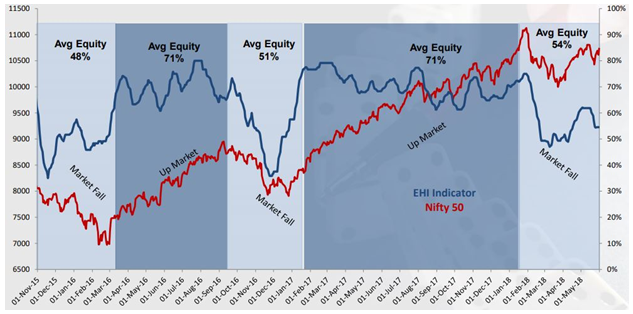
Source: Edelweiss Mutual Fund
Edelweiss Balanced Advantage Fund versus Sensex and Gold
Let us see how Edelweiss Balanced Advantage Fund performed versus Sensex and Gold on 1 year rolling basis over the last 5 years.
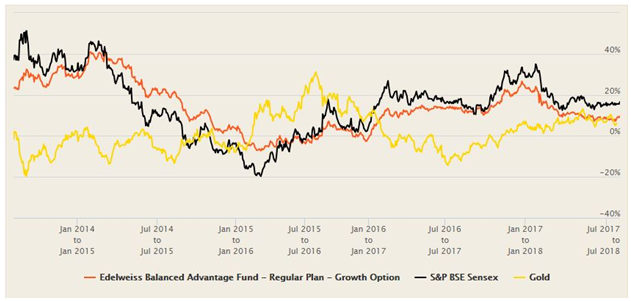
Source: Advisorkhoj Research
You can see that Edelweiss Balanced Advantage Fund tracked market (Sensex) returns in up markets, but provided considerable downside protection in corrections. The fund provided stability and at the same time gave equity like returns. The rolling returns chart of the fund shows that the investment strategy has worked for investors. Edelweiss Balanced Advantage Fund outperformed gold in most periods, except for a brief period in 2015 – 2016.
Dividend Track Record
Edelweiss Balanced Advantage Fund has an excellent quarterly dividend track record (please see the table below).
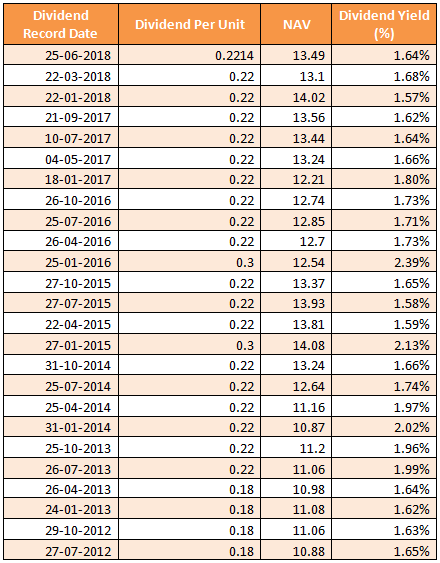
Source: Advisorkhoj Research
The scheme has also been paying regular monthly dividends (in its monthly dividend option) for almost a year now.
Conclusion
In this post, we discussed how Edelweiss Balanced Advantage Fund is a unique dynamic asset allocation investment proposition. The fund has been a consistent performer for the past few years. In our view, given the characteristics of the fund, investors should have a longer horizon for this fund. Investors should consult with their financial advisors if Edelweiss Balanced Advantage Fund is suitable for their investment needs.
Mutual Fund Investments are subject to market risk, read all scheme related documents carefully.
Queries
-
What is the benefit of mutual fund STP
Aug 29, 2019
-
How much to invest to meet target amount of Rs 2 Crores
Aug 26, 2019
-
Can I achieve my financial goals with my current mutual fund investments
Aug 24, 2019
-
Can you tell me return of various indices
Aug 19, 2019
-
What would be the post tax return on different investments
Aug 18, 2019
-
Which Principal Mutual Fund scheme will be suitable for my retirement corpus
Aug 16, 2019
-
What is the minimum holding period for availing NCD interest
Aug 4, 2019
Top Performing Mutual Funds
Recommended Reading
Fund News
-
Bank of India Mutual Fund launches Bank of India Mid Cap Fund
Jul 31, 2025 by Advisorkhoj Team
-
360 ONE Mutual Fund Fund launches 360 ONE Multi Asset Allocation Fund
Jul 30, 2025 by Advisorkhoj Team
-
Sundaram Midcap Fund: Celebrating 23 Years of Consistent Outperformance and Disciplined Growth Investing
Jul 30, 2025 by Sundaram Mutual Fund
-
India's first woman AMC founder wants to build a mutual fund empire from Tier-2 India
Jul 29, 2025 by Moneycontrol
-
Kotak Mahindra Mutual Fund launches Kotak Active Momentum Fund
Jul 29, 2025 by Advisorkhoj Team






